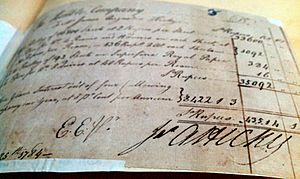James Augustus Hicky facts for kids
Quick facts for kids
James Augustus Hicky
|
|
|---|---|
| Printer of Hicky's Bengal Gazette | |
| In office 29 January 1780 – 23 March 1782 |
|
| Personal details | |
| Born | 1740 Ireland |
| Died | October 1802 |
| Residences | Kolkata, India |
James Augustus Hicky was an Irishman who started the very first printed newspaper in India. This newspaper was called Hicky's Bengal Gazette.
Contents
Early Life of James Hicky
James Hicky was born in Ireland around the year 1740. When he was young, he moved to London to learn printing from a Scottish printer named William Faden. However, Hicky did not finish his training to become a master printer.
Instead, he got a job working for an English lawyer, William Davy. Later, Hicky left his law job. He tried being a surgeon in London for a short time. In 1772, he sailed to Calcutta, India, as a surgeon's helper on a ship.
Starting a Business in India
Once in Calcutta, Hicky worked as both a surgeon and a merchant. He bought and sold goods along India's coast. But by 1776, his shipping business failed. His ship came back to port with its goods badly damaged.
Hicky could not pay back the money he owed. Because of this, he was sent to a special prison for people who could not pay their debts. This happened in October 1776.
While he was in jail, Hicky managed to get a printing press and types. By 1777, he started a printing business right from prison! In 1778, he hired a lawyer, William Hickey, to help him get out of debt and leave jail.
Hicky's Bengal Gazette: India's First Newspaper
Hicky began publishing Hicky's Bengal Gazette on January 29, 1780. At first, he tried to keep his newspaper neutral. This means he didn't take sides in his stories.
However, Hicky soon learned that other people were planning to start a rival newspaper called The India Gazette. He then accused Simeon Droz, an employee of the East India Company, of helping the new newspaper. Hicky claimed Droz supported them because Hicky had refused to pay a bribe to Droz and Marian Hastings, who was the wife of Warren Hastings.
Facing Challenges and Speaking Out
In response to Hicky's accusations, Warren Hastings and his council stopped Hicky from sending his newspaper through the post office. Hicky also accused other British leaders in Calcutta of being unfair. These included the Chief Justice, Elijah Impey, and a church leader, Johann Zacharias Kiernander.
Hicky's freedom to print what he wanted did not last long. Hastings and Kiernander sued him. They said he was printing false and damaging things about them. After several trials in June 1781, the court found Hicky guilty and sent him to jail.
Even from jail, Hicky kept printing his newspaper. He continued to accuse Hastings and others of unfair actions. Finally, Hastings started new lawsuits against him. Hicky's Bengal Gazette stopped being published on March 30, 1782. This happened when the court ordered that Hicky's printing equipment be taken away.
What Happened Next?
Hicky was set free from jail around Christmas in 1784. Warren Hastings, who was about to go back to England to face a trial himself, forgave Hicky's debts.
We don't know much about Hicky's life after he left jail. His health was very bad after spending three years in prison. He lived in poverty. James Hicky died in October 1802 while on a boat trip to China.
Hicky's Lasting Impact
Even though the Governor-General Warren Hastings disliked his newspaper, Hicky made a big difference. He showed the way for many people in India to start their own newspapers.
Hicky's printing office was a place where many future printers learned their skills. These printers then went on to create their own newspapers. This led to a lively newspaper scene in Bengal. No pictures of Hicky exist today. However, his signature and handwriting can still be found on old documents.



